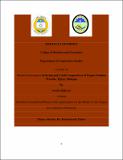| dc.description.abstract | Savings and Credit Cooperatives (SACCO) provide the capital to improve the income of the
farm and non farm sector. Still most of the poorest do not have access to the formal financial
institutions in Ethiopia and they depend on informal sources for their credit needs. SACCOs are
evolving as promising intermediaries to enable the poor link with the formal financial
institutions. Promotion of SACCO brings in vibrancy to the local economy as it unfolds business
opportunities to the poor and marginalized farmers especially women and enables them to come
out of poverty.
The study was conducted in Degua Tembien Woreda, South Eastern Tigray, Ethiopia, with the
objectives: a) to investigate the level of participation of women in saving and credit Cooperatives
b) to analyze the economic gains derived by women members after joining the cooperative c) to
identify the influential factors that affects the participation of the women in saving and credit
cooperatives d) to suggest possible recommendations for the participation of women in saving
and credit Cooperatives.
To address the objectives of the study, both quantitative and qualitative methodologies were used
in this study. Data were collected from primary and secondary sources, the primary data
necessary for the quantitative study were collected through personal interviews from 110 farmers
drawn from four saving and credit cooperatives by conducting formal survey using structured
interview schedule.
Qualitative data were collected through focus group discussion, observations, and formal
discussion with key informant’s experts from cooperative office. This study used a two stage
sampling procedure in which both purposive and random sampling techniques were used to
select the tabias and sample respondents.
Descriptive statistics with appropriate statistical tests, Pearson’s Product-Moment Correlation,
chi-square, and other relevant tests were used to analyze the data collected for the study. Tables
and pie-chart were used to interpret the data. From the result of descriptive analysis, women
participation at different level of management committees and in leadership was very low.
5
Accordingly, the level participation in leadership 78.1 % of the respondents are classified as
simple member in the leadership, 15.5% participated in different sub committees and only 6.4%
were participated or member of the management committees. This indicated that women were
not given attention in leading the cooperative at higher level. But the economic again after
joining RUSACCOs has increasing significantly even though the numbers of the beneficiaries
were limited.
The economic model analysis reveals that the combination effect of the dependent variables
(leadership, different committees and general assembly meeting) of women participation in
RUSACCOs has determined with independent variables of membership duration, training,
saving and annual income. | en_GB |


